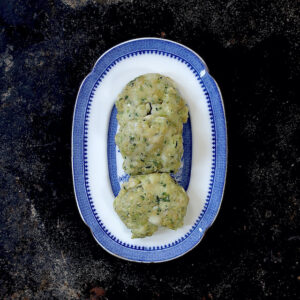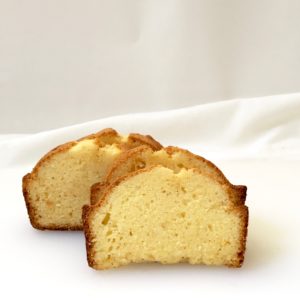Lemon Cake With Crackly Lemon Sugar Topping

The great thing about this cake are all things you don’t need to make it: fancy equipment, fancy ingredients, baking ability. All that, plus it’s delicious and keeps really well, provided you don’t wolf it down in one sitting.
This recipe comes courtesy of Diana Henry’s Plenty, written in 2010, well before another, more famous Plenty made its debut. Like all of Henry’s cookbooks, Plenty is full of terrific recipes–pork belly with star anise, cherry wine, wonderful salads. I have no idea why Henry isn’t better known in the United States. She should be.
Henry’s recipe calls for ingredients the IK doesn’t stock: self-rising flour, for one. When the need arises, I take a page from Nigella Kitchen, where Nigella suggests adding 2 teaspoons baking powder to 1 cup of all-purpose flour, creating self-rising flour at home. As Henry’s recipe requires 1 3/4 cups flour–just under 2 cups–my math-impaired mind quickly clouded. Fortunately, John was home.
 Have I mentioned John is an engineer? Who is therefore in possession of numeric prowess? He scribbled a couple equations and told me to use 3 1/2 teaspoons of baking powder. He tried to explain why, but it involved decimals, which give me anxiety attacks. Thanking him profusely, I wrote “three and a half” on a sticky note and hurried back to the kitchen.
Have I mentioned John is an engineer? Who is therefore in possession of numeric prowess? He scribbled a couple equations and told me to use 3 1/2 teaspoons of baking powder. He tried to explain why, but it involved decimals, which give me anxiety attacks. Thanking him profusely, I wrote “three and a half” on a sticky note and hurried back to the kitchen.
Henry also asks you to sift the flour. Being no fan of flour sifters, I take the strainer-over-a-measuring cup route. But go your own way (you can call it another lonely day).
This cake is more like a quick muffin batter than fine pastry–likely why I can bake it. The butter and lemon juice provide all the liquid, and you aren’t supposed to overmix, lest you activate the gluten. The first time I baked this, it worked a dream. Naturally, when I baked it for the blog, the ingredients misbehaved. There wasn’t enough liquid to incorporate the flour. Welcome to real life in the kitchen, where variables in ingredients, weather, and equipment try wreaking havoc.
For a moment I looked down into the bowl of sunshiny yellow batter and plotzed (Yiddish slang for dropping dead). Then I pulled it together. I mean, this isn’t Belgium. It’s a cake. How to fix it?
I squeezed in another half lemon. Still too dry. Would more water work? I poured in about 1/3 cup. Violà-The batter relaxed, finding itself. It looked and tasted like cake batter. Best of all, it baked beautifully.
So however unorthodox this may seem, proceed with the recipe, and if necessary, add a little water. Don’t let the ingredients control you.
While the cake bakes, make the topping, which takes this from from ho-hum snack material to dangerous dessert. Henry calls for another renegade ingredient the IK doesn’t stock–superfine sugar (I’ll spare you the Styx lyrics)–which isn’t to be confused with Confectioner’s Sugar. Superfine sugar is just what it sounds like–sugar, ground superly fine. Like self-rising flour, you yourself can produce this at home. Place plain sugar in a spice grinder or food processor. Hit the power switch.

This superfine sugar is mixed with more fresh lemon juice and poured over the warm cake. Then, using all your willpower, allow the cake to cool completely. The topping will form a crackly crust.

Henry notes this cake may be made with limes, too, though you must double the amounts of fruit. Oranges might be worth a try, too, or even a blend of citrus fruits. I used Meyer lemons, thought to be a cross between regular lemons and either mandarins or other oranges. Meyer Lemons are the platonic ideal of lemon, deeply flavored, thin-skinned, juicy, and intensely fragrant.

Lemon Cake With Crackly Lemon Sugar Topping
adapted from Diana Henry’s Sugar-Crusted Lemon Loaf Cake in Plenty
Yield: I loaf cake
Baking time: approximately 45 minutes
for the cake
1 3/4 cups all-purpose flour, sifted
3 1/2 teaspoons baking powder
pinch salt
9 tablespoons cold unsalted butter, diced
2/3 cup granulated sugar
2 eggs, beaten
2 unwaxed lemons, ideally organic, Meyer if possible, first zested, then juiced into the same bowl (see notes on handling lemons)
1/3 cup water (see notes)
for topping
juice of two lemons
1/2 cup superfine sugar or regular sugar, ground finely in a spice grinder, mini-processor, or food processor.
Preheat oven to 350F. Butter a 9×5 inch loaf pan and line with wax paper by tearing off a sheet and fitting into the pan. It won’t burn while baking.
Sift flour either using sifter or by placing a small strainer over a measuring cup. I use a 2 cup measuring cup and spoon the flour into the strainer, then shake, gently and carefully, until I reach 1 3/4 cups. It takes a few minutes, but it works. Add the baking powder through the strainer into the measuring cup.
Pour into a mixing bowl. Add pinch salt.
Rub butter into flour with your fingers until it looks like bread crumbs. For this step, take care to dice butter into small pieces.
Add sugar, eggs, lemon juice and zest.
Stir to incorporate. Do not overmix. You should have a fairly loose batter. If your batter is very dry, add a little water until it loosens up, up to 1/3 cup. I once baked this with a batter so dry that I lifted it out of the bowl by hand. The cake came out fine.
Normally you’ll find this more like a muffin batter: it should blend in a few strokes. Using a spatula, scrape into the loaf pan.
Bake 45-55 minutes, until a tester comes out clean.
While the cake bakes, make the topping.
Juice two lemons into a small bowl.
If you don’t have superfine sugar, place 1/2 cup sugar in small food processor, regular food processor, or spice grinder. Pulse briefly.
Add sugar to bowl of lemon juice. Combine with a fork.
When cake is done, place on cooling rack. Allow to cool for ten minutes. Then prick all over with skewer or fork. Slowly pour the topping over the cake. It will run down the sides and pool slightly in the corners. That’s okay. Allow to cool completely before slicing.
I find it’s less mess to keep the cake in the pan, covered with foil–you lose less topping that way. Cake keeps at room temperature up to 5 days, reviving nicely with a little heating. Wrapped well, it freezes beautifully.
Note about lemons: if you cannot find unwaxed lemons, scrub them well with very warm soapy water. This should get the wax off. Dry thoroughly. Zest before juicing. If you don’t own a zester or Microplane, use a vegetable peeler and mince finely.





